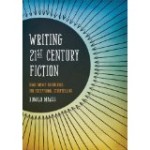One of my favorite “how to write” authors is literary agent Donald Maass, of Writing the Breakout Novel fame. In his newest book on fiction techniques, Writing 21st Century Fiction, he discusses microtension.
Writing Tip for Today: Exactly what is microtension and how do you use it in fiction?
- Microtension is Two-Faced. According to Maass, Microtension utilizes conflicting or contrasting emotions (to) generate reader uneasiness. These conflicts can be external or internal, but think of them as what goes on in a scene that doesn’t get said, and what doesn’t get done. John Updike called it writing “about the difference between what we want and what is.” This uneasiness or anxiety if you will, causes the reader to wish for a solution, and so she reads the next line, looking for that answer.
- Tension in Every Line. You may have heard the old fiction advice, “Put tension on every page.” Maass urges writers to go farther and build tension into every line. In life, we often harbor the opposite feeling than the one we project–smiling as you endure Aunt Edna’s fiftieth retelling of a boring story, acting unaffected as your spouse levels a hurtful barb, being passed over as the writing contest winners are announced. We also say the opposite of what we mean: “Oh your novel sounds great!” even though we really mean, I wouldn’t read that if you paid me! We often go to great lengths to hide our true feelings and the same is true of our characters. The reader, privy to the POV character’s feelings and thoughts, will sense the tension in every word the POV character says (or doesn’t say). MICRO-tension helps build tension, conflict and suspense.
- Opposites Attract. When you use microtension, focus on the opposite of what your POV character wants, the secrets she cannot divulge, the guilt and shame of doing things the character shouldn’t be doing. Your overall novel premise should give the reader a clear picture of what that character WANTS and what OBSTACLES are standing in the way. But you as the author must also know, in intimate detail, what your character DOESN’T WANT–things that scare the daylights out of the character, people and situations where the character must betray his own ethics, decisions that eat away at the character’s moral code. When you pump these hidden things into the tension of the overall story, you will up the stakes of the entire story. Microtension should be balanced (inner conflict v. outer conflict,) but according to Maass, it’s darned near impossible to overload a story’s tension–in fact, he says, most manuscripts don’t have ENOUGH conflict. With microtension, you’ll have another tool at your disposal. For more on microtension, see Maass’ book, Writing 21st Century Fiction.





